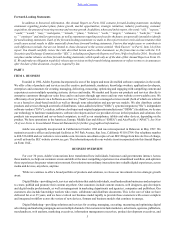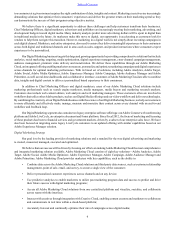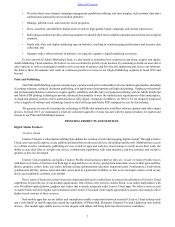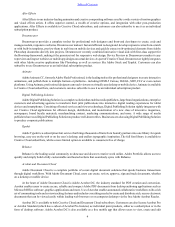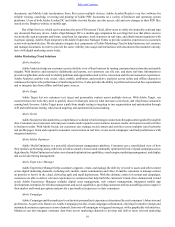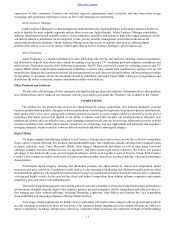Adobe 2015 Annual Report Download - page 12
Download and view the complete annual report
Please find page 12 of the 2015 Adobe annual report below. You can navigate through the pages in the report by either clicking on the pages listed below, or by using the keyword search tool below to find specific information within the annual report.
Table of Contents
12
and retail distribution. We face direct and indirect competition in the consumer digital imaging market from a number of companies
that market software that competes with ours.
The stock content market has significant competition, especially in the microstock segment, where Adobe primarily operates
today with Fotolia.com and the newly launched Adobe Stock offering. Key competitors in this market include Shutterstock,Getty
Images and a number of smaller companies. Adobe Stock’s deep product integration with Creative Cloud and superior reach and
relationships with creative professionals around the world differentiate our offerings.
In addition, we face competition from device, hardware and camera manufacturers as they try to differentiate their offerings
by bundling, for free, their own digital imaging software, or those of our competitors. Similarly, we face potential competition
from operating system manufacturers as they integrate or offer hobbyist-level digital imaging and image management features
with their operating systems. We also face competition from smartphone and tablet manufacturers that integrate imaging and video
software into their devices to work with cameras that come as part of their smartphone and tablet offerings. In addition, social
networking platforms such as Facebook (including Instagram), Snapchat, Twitter (including Vine) and Pinterest, as well as portal
sites such as Google and Yahoo! are becoming a direct means to post, edit and share images, bypassing the step of using image
editing and sharing software. Online storage and synchronization are becoming free and ubiquitous. Consumers in particular will
be encouraged to use the image and video editing software offered by those storage products, thus competing with our software.
Competition is also emerging with imaging and video applications on smartphone and tablet platforms. Competitors are
extending their products and feature sets to platforms such as Apple’s iPhone and iPad, and other smartphone and tablet devices.
Similarly, new cloud-based offerings continue to emerge which offer image editing and video-editing capabilities, as well as social
and sharing features.
As customers such as publishers and media companies increase their desire to deliver their assets to new platforms, we
expect new and existing companies to continue to offer solutions that address these challenges that are competitive with our Digital
Publishing Solution. Many design agencies are building capabilities to offer such solutions, and companies such as Amazon, Apple
and Google offer an alternative format and business model for the delivery of newspaper and magazine content to mobile devices.
The nature of traditional digital document creation, storage, and collaboration has been rapidly evolving as knowledge
workers and consumers shift their behavior increasingly to non-desktop workflows. Competitors like Microsoft, Google, Box and
Dropbox all offer competitive alternatives to our Document Cloud business for creating and managing PDFs. In addition, other
PDF creation solutions can be found at a low cost or for free on the web. To address these competitive threats, we are working to
ensure our Adobe Document Cloud applications stay at the forefront of innovation in emerging opportunities such as PDF document
generation, document collaboration and document security.
As electronic signatures with Adobe eSign Services are quickly becoming a core element of digital documents, competitors
such as DocuSign and Citrix have been jumping in to take advantage of the growing space. We face strong competition from these
and other companies in this market.
Digital Marketing
The markets in which our Digital Marketing business unit competes are growing rapidly and characterized by intense
competition. Our Adobe Marketing Cloud solutions face competition from large companies such as Google, IBM, Oracle,
salesforce.com, SAP, SAS, Teradata and others, in addition to point product solutions and focused competitors. Additionally, new
competitors are constantly entering these markets. Some of these competitors provide SaaS solutions to customers, generally
through a web browser, while others provide software that is installed by customers directly on their servers. In addition, we
compete at times with our customers’ or potential customers’ internally developed applications. Of the competitors listed above,
no single company has products identical to our Adobe Marketing Cloud offerings. Adobe Marketing Cloud competes in a variety
of areas, including: reporting and analytics; cross-channel marketing and optimization; online and social marketing; audience
management; video delivery and monetization; web experience management and others.
Many of the companies with which we compete offer a variety of products or services and as a result could also bundle
their products or services, which may result in these companies effectively selling their products or services at or below market
prices for individual products. In addition, large software, Internet and database management companies have expanded their
offerings in the digital marketing area, either by developing competing services or by acquiring existing competitors or strategic
partners of ours. We believe competitive factors in our markets include the proven performance, security, scalability, flexibility
and reliability of services; the strategic relationships and integration with third-party applications; the intuitiveness and visual
appeal of user interfaces; demonstrable cost-effective benefits to customers; pricing; the flexibility of services to match changing
business demands; enterprise-level customer service and training; perceived market leadership; the usability of services; real-time
data and reporting; independence from portals and search engines; the ability to deploy the services globally; and success in
educating customers in how to utilize services effectively. We believe we compete favorably with both the enterprise and low-



